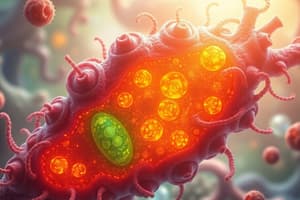Podcast
Questions and Answers
What are the three domains of living organisms according to modern classification systems?
What are the three domains of living organisms according to modern classification systems?
Eukarya, Bacteria, and Archaea
What distinguishes Eukarya organisms from Bacteria and Archaea?
What distinguishes Eukarya organisms from Bacteria and Archaea?
Eukarya organisms have cells with a nucleus and other membrane-bound organelles, and they typically form multicellular structures like animals and plants.
In which domains can unicellular organisms lacking a nucleus and other membrane-bound organelles be found?
In which domains can unicellular organisms lacking a nucleus and other membrane-bound organelles be found?
Bacteria and Archaea
What are the two subdomains of unicellular organisms classified under the domain Bacteria?
What are the two subdomains of unicellular organisms classified under the domain Bacteria?
What unique features distinguish Archaea from Bacteria and Eukarya?
What unique features distinguish Archaea from Bacteria and Eukarya?
Flashcards
What are the levels of organization in living organisms?
What are the levels of organization in living organisms?
Living organisms are highly organized, with a hierarchy that includes atoms, molecules, organelles, cells, tissues, organs, and organ systems.
What is the key characteristic that allows living organisms to interact with their environment?
What is the key characteristic that allows living organisms to interact with their environment?
Living organisms can respond to stimuli in their environment, such as light, touch or chemicals, and adapt their behavior accordingly.
What is the process of reproduction that living organisms undergo?
What is the process of reproduction that living organisms undergo?
This is a defining characteristic of life, where both single-celled and multicellular organisms can create offspring.
What is homeostasis and how does it relate to living organisms?
What is homeostasis and how does it relate to living organisms?
Signup and view all the flashcards
What are Eukarya and what is a key characteristic of organisms in this domain?
What are Eukarya and what is a key characteristic of organisms in this domain?
Signup and view all the flashcards
Study Notes
Living Organisms: An Overview
Living organisms are complex, organized structures that exhibit certain characteristics that define life. These characteristics include order, stimuli response, reproduction, growth/development, regulation, homeostasis, and energy consumption. Living organisms can be classified into three domains: Eukarya, Bacteria, and Archaea. This article will discuss the key features of living organisms, focusing on their organization, interactions with the environment, and the processes that drive their survival.
Organization and Structure
Living organisms are highly organized, with a hierarchy that includes atoms, molecules, organelles, cells, tissues, organs, and organ systems. They can be either unicellular or multicellular, with unicellular organisms composed of a single cell and multicellular organisms made up of numerous cells. Regardless of their complexity, all living organisms exhibit the following characteristics:
- Order: Living organisms have a structured organization, with cells working together to perform various functions.
- Interaction with the Environment: Organisms can respond to stimuli, such as light, touch, or chemicals, and adapt their behavior accordingly.
- Reproduction: The ability to reproduce is a defining feature of life, with both single-celled and multicellular organisms capable of reproduction.
- Growth and Development: Living organisms undergo regulated growth and development, with cells becoming specialized and differentiated to perform specific functions.
- Regulation: Organisms maintain homeostasis, or a stable internal environment, by regulating their physiological processes.
- Energy Consumption: Living organisms use energy to maintain their metabolic processes, obtaining energy from various sources such as sunlight, nutrients, or chemicals.
Classification and Diversity
Biologists have traditionally grouped living organisms into five kingdoms: animals, plants, fungi, protists, and bacteria. However, modern classifications systems now recognize three domains: Eukarya, Bacteria, and Archaea. This three-domain system is based on the organization of cells, their membrane-bound organelles, and other cellular structures.
- Eukarya: These organisms have cells with a nucleus and other membrane-bound organelles, and they typically form multicellular structures like animals and plants.
- Bacteria: These unicellular organisms lack a nucleus and other membrane-bound organelles, and they can be further classified into two subdomains: true bacteria (Eubacteria) and archaea (Archaeobacteria).
- Archaea: These unicellular organisms share some characteristics with bacteria and eukaryotes, but they have their own unique features, such as a single RNA polymerase subunit and cell wall compositions.
Conclusion
Living organisms are complex, organized structures that exhibit a range of characteristics that define life. They are classified into three domains based on their cellular organization and shared evolutionary relationships. Understanding the organization, interactions, and processes that drive the survival of living organisms is crucial for appreciating the diverse and interconnected world of life on Earth.
Studying That Suits You
Use AI to generate personalized quizzes and flashcards to suit your learning preferences.




